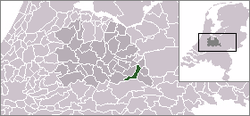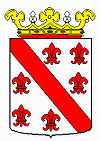Amerongen
| Amerongen | ||
|---|---|---|
| ||
 | ||
| Coordinates: 52°0′9″N 5°27′39″E / 52.00250°N 5.46083°E | ||
| Country | Netherlands | |
| Province | Utrecht | |
| Municipality | Utrechtse Heuvelrug | |
| Population (12 jun 2007) | 14,275 | |
Amerongen (52°0′N 5°28′E / 52.000°N 5.467°E) is a village in the central Netherlands (province Utrecht) on the border of the Utrecht Hill Ridge. It lies about 7 km south west of Veenendaal (10.5 km by road).
The landscape rises from the flat water meadows of the Nederrijn (Lower Rhine) to the Utrecht Hill Ridge ("Utrechtse Heuvelrug"). The highest point in the western Netherlands is located 2 km east of the village. The Amerongense Berg (Amerongen Mountain) has a height of 69 metres above sea level.
History
The history of Amerongen is closely related to that of Castle Amerongen. This castle was first established in 1286 as a wooden donjon but was rebuilt in stone. It was attacked or destroyed by fire and rebuilt several times during the following centuries. In 1672 the Netherlands were invaded by the French army and in early 1673, the castle was deliberately burned down as a punishment for non-payment of taxes levied by the French. Shortly afterwards the castle was rebuilt, under the capable supervision of Margaretha Turnor, wife of Van Reede, owner of the castle and special envoy to the court of Brandenburg at this time. The newly built and extended castle, arose in the Dutch Classisist style and, although the grounds and gardens were remodelled at various time and the interior brought up to date by Cuyper in the early twentieth century, it remains a prime example of this style.
The former Emperor of Germany, Wilhelm II, sought refuge in the Netherlands in November 1918 and lived in the castle until May 1920, when he moved to Doorn, where he spent the rest of his life. It was in the Castle of Amerongen that he signed the Act of Abdication.
Until January 1, 2006, Amerongen was a separate municipality, which covered the village of Amerongen itself, Overberg, and the western part of the village of Elst. Elst has been transferred to the municipality of Rhenen; the largest part of the municipality has merged with four other municipalities to form the new municipality of Utrechtse Heuvelrug.
In 2001, the village of Amerongen had 5169 inhabitants. The built-up area of the village was 1.21 km², and contained 2072 residences.[1]
“Amerongen”, “Van Amerongen” and “Van NieuwAmerongen” are last names that possibly indicate that their ancestors emigrated from this area.
Gallery
-
Amerongen, castle: kasteel Amerongen
-
Amerongen, church: Andrieskerk
-
Amerongen, windmill: molen Maallust
External links
| Wikimedia Commons has media related to Amerongen. |
- J. Kuyper, Gemeente Atlas van Nederland, 1865-1870, "Amerongen". Map of the municipality in 1868.
- Official Site of the Utrechtse Heuvelrug
References
- ↑ Statistics Netherlands (CBS), Bevolkingskernen in Nederland 2001 . Statistics are for the continuous built-up area.
| ||||||||||||||



